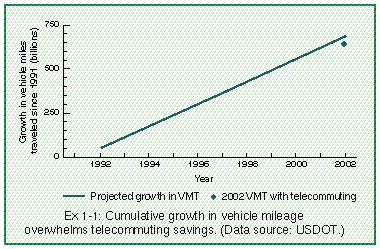
![]()
Telecommuting is the most widely recognized trip-saving application of telecommunications. Telecommuting usually means office-based employees using telecommunications to work at their homes or at a nearby alternative office for a few days each week instead of commuting a longer distance to work.
State-government-sponsored studies of telecommuting in California (Kitamura, 1990; Handy and Mokhtarian, 1993) and Washington State (Heifetz, 1992; Kunkle, 1992; Quaid and Lagerberg, 1992) have found that telecommuting produces an overall net reduction in all household driving, a net energy benefit even with some small additional energy use at the telecommuting site, and a generally positive performance and satisfaction result for both workers and their employers.
Early concerns that telecommuting might lead to offsetting increases in transportation, either by other family members who have an extra car available on telecommuting days or by telecommuters who quit early on Friday to take longer weekend recreational trips, have not been borne out by the California and Washington State studies. Travel diaries from households where workers begin to telecommute show reduced commuting and fewer household trips overall than those from nontelecommuting households.
These are tentative findings, however, constrained by the limited time that most telecommuting study projects have been active. In the long term, telecommuting could affect people's decisions about where to live. If an employee only goes to work at the office one or two days per week, she might be willing to have a two-hour commute so she can live in beautiful countryside. No longitudinal studies that could detect this pattern have been done yet.
Also, the studies from Washington State and California did not address the overall impact of information technology on travel behavior beyond the effects of telecommuting.
The 1993 USDOT National Telecommuting Study, Transportation Implications of Telecommuting (USDOT, 1993, p. ix), forecasts that telecommuting in the early 21st century is likely to grow to where it reduces vehicle miles traveled (VMT) in the range of 18 to 35 billion miles per year. Consequently, with telecommuting, VMT will be at most 1.4% below where it might otherwise be without telecommuting. This reduction stands in contrast to USDOT's forecast of 2.5% annual VMT growth (USDOT, 1993a) or the U.S. Department of Energy's forecast of 1.8% annual VMT growth through the year 2000 (USDOE, 1993). The USDOT characterized telecommuting as having "significant transportation-related public benefits" (USDOT, 1993, p. v), even though these numbers show that the travel reductions predicted for telecommuting are likely to be overwhelmed by growth in travel volumes. Exhibit 1-1 presents a graphical depiction of forecast travel growth over the next ten years with no consideration of telecommuting. The small dot just below the forecast trend line is where VMT would be in the year 2002 if the USDOT high estimate for telecommuting were to materialize.

![]()
A follow-up study from the United States Department of Energy, Energy, Emissions, and Social Consequences of Telecommuting, found three indirect effects of telecommuting that, on balance, make the direct VMT reduction impacts forecast by USDOT even less likely. These indirect effects are described by USDOE (USDOE, 1993, p. xi) as follows:
Latent Demand. People who previously avoided using their vehicles because traffic was too congested will start driving more because telecommuting has lessened this congestion. This will tend to offset the direct reductions in fuel use and emissions.
Increased Urban Sprawl. As close proximity to a central workplace diminishes in importance, telecommuters will feel free to live farther from urban centers. This geographic expansion of cities will lead to longer drives when these workers do use their vehicles, and it will require additional highway construction.
![]()
Click on a button to view a section of this chapter:
![]() Beyond Telecommuting
Beyond Telecommuting
![]() From Telecommunications to Telematics
From Telecommunications to Telematics
![]() Four Telephenomena Affecting Travel
Four Telephenomena Affecting Travel
![]() Goals of This Study
Goals of This Study
![]()
Go to:
![]()